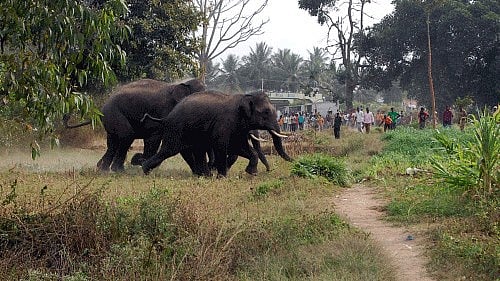
Representative image of wild elephants.
Credit: DH Photo
Guwahati: The "illegal" electric fences put up by villagers to protect their crops have been identified as the biggest killer of wild elephants in Assam in the past 23 years, between 2000 and 2023, as problem of human-elephant conflicts turns grim across the state.
The first ever government-funded study on Elephant-Human Conflict in the state of Assam conducted by the Wildlife Institute of India (WII) found that 626 elephants died in such conflicts, of which 209 were caused due to electrocution followed by accidents, train collisions (67), poaching (55), poisoning (62) and others.
"Electrocution incidents occur due to illegal direct connections from distribution lines to electric fences, often used by villagers for crop protection. Our findings align with previous studies indicating a significant rise in electrocution related fatalities since 2016, particularly in regions such as Dhansiri and Chirang," said the report. The report was released recently.
It also found that a total of 1,468 humans died and 337 got injured in 1,806 human-elepant conflict incidents during the period. Most of the human casualties were recoded in Sonitpur West (202), Udalguri (202), Golaghat (202), Sonitpur East (177) and Goalpara district (175).
With over 5,800 elephants (2024 report), human-elephant conflicts have turned serious in Assam since 1980s, when infrastructure development works picked up.
Karnataka, Assam and Kerala are among the states with high Asian elephant populations. According to an estimate, more than 400 people die in such conflicts in the country every year while more than 100 jumbos are also killed in retaliation.
Adult males
The study found that the adult males, the ecological keystones of elephant population, were found to be most affected by anthropogenic factors, particularly electrocution and retaliatory killings (199).
This, according to the report, could threaten the long-term stability of elephant populations in the area, as males play a crucial role in social structures, gene flow, and maintaining healthy herd dynamics.
"The adult males are disproportionately affected, likely due to their larger size and greater mobility within elephant herds."
Areas of conflict
The study said spatial analysis of elephant mortality hotspots, coupled with landscape fragmentation metrics, revealed that areas with high elephant mortality are located near human settlements, croplands, and linear infrastructures such as roads and railways.
"The expansion of railway tracks and poorly maintained power lines, illegal use of electricity from distribution lines for fencing has contributed significantly to elephant deaths, highlighting the urgent need for action-based mitigation of human elephant conflicts," it said.
The study identiied Nagaon region with highest elephant mortality (76) followed by Sonitpur West (71) Dhansiri (48) Karbi Anglong East (47) Golaghat (46) Sivasagar (38), during the period.
It identified 217 villages with elephant deaths and three of them reported maximum jumbo deaths: Behroni in Nagaon (27) Digboi in Tinsukia (26) and Natum Salona tea estate, also in Nagaon (25).
"Areas where human-elephant interactions are frequent are near highly fragmented forests, agricultural fields, and encroached elephant corridors.
Push factors
The study identified change in land use patterns, deforestation and rapid urbanisation as the major push factors for increasing human-elephant conflicts.
"The land use pattern analysis demonstrates that deforestation and the expansion of agricultural areas have led to increased habitat fragmentation, which has severe consequences for elephant movement and mortality. The expansion of built-up areas, particularly near critical elephant habitats, amplifies the risks of human-elephant conflict, as elephants venture closer to these human-dominated spaces in search of food and water," it said.
"Human expansion into elephant ranges has disrupted their migratory routes, often forcing them to enter human settlements in search of food and water, further escalating conflict."
It said the post-monsoon period recorded the highest number of fatalities. As forest degradation continues, elephants are increasingly forced into human settlements, where they are more vulnerable to electrocution, train collisions, and other infrastructure-related hazards (trenches, drains, water canals).
The report highlighted the need for targeted conflict mitigation strategies, including seasonal monitoring and community engagement during periods of high conflict.
Human-elephant conflict (2000-2023)
Elephant deaths in conflicts: 629
Electrocution: 209
Accidental deaths: 127
Anthropogenic stressors: 97
Train collisions: 67
Poisoning: 62
Poaching: 55
Retaliatory killings: 5
Vehicle collisions: 4
Villages with mortality: 217 villages
Human deaths: 1,468
Humans injured: 337